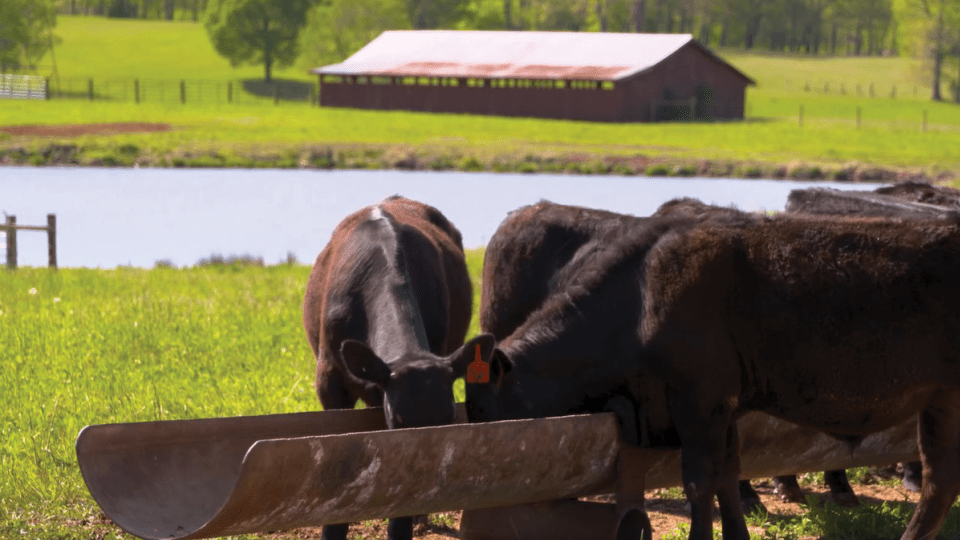Feed dewormers are an easy and viable option for summer parasite management
By Dr. Jacques Fuselier
Parasites are a major challenge for cattle health and performance. They rob nutrients and efficiency from their bovine hosts while stealing profit from producers.
Non-parasitized cattle will have better feed intake, average daily gain, milk production, as well as a positive immune response to vaccines and diseases.1,2 That’s why using the right dewormers at the right time is critical to a successful grazing program.
In mid-summer 2021, a research trial assessed the effectiveness of utilizing SAFE-GUARD® (fenbendazole) in the daily feed supplement to deworm stocker cattle on pasture.3 The purpose of the trial was to see if this step would reduce the amount of unthrifty cattle being seen at the end of the grazing period.

The trial protocol involved two separate groups of 50 head each. Cattle in both groups were treated the exact same on arrival in early June in terms of processing, vaccinating and deworming.
The only difference was that one group was given SAFE-GUARD (2.27 milligrams fenbendazole/pound body weight) mixed in with the daily feed supplement 28 and 56 days after turnout while the control group was not. At day 70, which was the conclusion of the trial, all calves were individually weighed.
Every 14 days, fecal egg count reduction test (FECRT) – a standardized diagnostic tool to test manure for the presence of intestinal parasite eggs – were collected from each group. The purpose was to determine when there would be a spike in parasites, which was seen around day 56 of the trial in the control group.
The results
Steers that were dewormed on days 28 and 56 gained 22 more pounds and had a 0.30-pound greater average daily gain than the control steers. At the conclusion of the trial, steers dewormed with SAFE-GUARD had an average fecal egg count of 0 eggs/3 grams, while control steers had an average fecal egg count of 128.6 eggs/3 grams.
Key takeaways
- There was not a lot of visual difference among the two groups at the end of the trial. The difference wasn’t realized until the cattle were weighed. We often think we can see an animal with parasites, but often the visual difference is minimal.
- After deworming, we often don’t know how effective the deworming was and the amount of time before reinfestation occurs. Work with your veterinarian to do FECRT testing. It is important that 20 samples are taken both at treatment and 14 days post-treatment. A successful deworming should result in a 90% or greater reduction in parasite eggs in feces.4 Ask your Merck Animal Health representative for a free FECRT kit.
- Deworming cattle doesn’t have to be labor intensive. Using feed and mineral forms of SAFE-GUARD – such as range cubes, dewormer blocks or mineral – require relatively little time and labor and, as this study demonstrated, are highly effective.
- Accurate dosing is critical. Not only will accurate dosing give the anthelmintic the best chance of working effectively, but it will also help reduce the development of resistance.
Deworming pays
Cattle producers want to be as efficient as possible. This trial showed that for roughly $2 per head, given twice, the producer saw $35-$40 per head return.
An Iowa State University study demonstrated cow/calf producers can add $274 per head of value through animal health technologies. Of that $274, $201 was a result of deworming. For stockers, $24 of the $95 per head impact of animal health technologies was due to deworming.5
Don’t forget the importance of deworming calves at cow side. At about six to eight weeks of age, calves start ruminating and are at high risk of internal worms. It is important to deworm them at the appropriate time. Deworming at earlier stages of infection can result in improved weaning weights. For spring calving herds, it typically is good to deworm calves six to eight weeks after turnout onto pasture.6
Incorporating strategic deworming provides a significant positive return on investment.
Important Safety Information | Residue Warnings
CATTLE: Do not use in beef calves less than 2 months old, dairy calves and veal calves. A withdrawal period has not been established for this product in pre-ruminating calves. Additionally, the following meat withdrawal and milk discard times apply:
Safe-Guard Paste: Cattle must not be slaughtered for 8 days. For dairy cattle, the milk discard time is 96 hours. \
Safe-Guard Suspension: Cattle must not be slaughtered for 8 days. For dairy cattle, the milk discard time is 48 hours.
Safe-Guard ENPROAL Type C Medicated Block: Cattle must not be slaughtered for 11 days. For use in beef cattle only.
Safe-Guard 20% Protein Type C Medicated Block: Cattle must not be slaughtered for 16 days. For use in beef cattle only.
Safe-Guard Type A and other medicated feed products (pellets, cubes, free-choice mineral, or free-choice liquid): Cattle must not be slaughtered for 13 days. For dairy cattle, the milk discard time is 60 hours.
Resources
- Smith, R. A., Rogers, K. C., Huse, S., Wray, M. I., Brandt, R. T., Hutcheson, J. P., Nichols, W. T., Taylor, R. F., Rains, J. R. & McCauley, C. T. (2000). Pasture deworming and (or) subsequent feedlot deworming with fenbendazole. I. Effects on grazing performance, feedlot performance and carcass traits of yearling steers. The Bovine Practitioner, 34(2), 104-114.
- Safe-Guard/Panacur Deworming Strategies for Dairy Cattle. Dairy Monograph. Intervet.
- Data on file.
- Dobson R, Jackson R, Levecke B, Besier B et al. Guidelines for fecal egg count reduction tests (FECRT). World Association for the Advancement of Veterinary Parasitology (WAAVP) (2001) Proceedings: 23rd International Conference of the World.
- Lawrence JD, Ibarburu MA. Economic analysis of pharmaceutical technologies in modern beef production in a bioeconomy era. 2007. Iowa State University.
- Kevin Gould, M. S. U. E. (2022, January 21). Beef cattle deworming strategies. MSU Extension. Retrieved May 18, 2022, from https://www.canr.msu.edu/news/beef_cattle_deworming_strategies.
Find more content for your beef operation.
About the author

Dr. Jacques Fuselier, D.V.M., D.A.C.T., D.A.B.V.P.
Technical Services Manager,
Merck Animal Health
